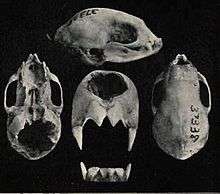Hairy-legged vampire bat
| Hairy-legged vampire | |
|---|---|
 | |
| Scientific classification | |
| Kingdom: | Animalia |
| Phylum: | Chordata |
| Clade: | Synapsida |
| Class: | Mammalia |
| Order: | Chiroptera |
| Family: | Phyllostomidae |
| Genus: | Diphylla Spix, 1823 |
| Species: | D. ecaudata |
| Binomial name | |
| Diphylla ecaudata Spix, 1823 | |
The hairy-legged vampire bat (Diphylla ecaudata) is one of three extant species of vampire bats. It mainly feeds on the blood of birds, but can also feed both on domestic birds and humans.[2] This vampire bat lives mainly in tropical and subtropical forestlands of South America, Central America, and southern Mexico. It is the sole member of the genus Diphylla.
Description
It generally rests during the daylight, with fewer than twelve other bats in a cave, although a cave was once found with thirty-five bats. It also shares its food via regurgitation, mouth to mouth.[3]
This bat has good eyesight, but poor echolocation.[4] It is often found in caves with the common vampire bat (Desmodus rotundus), but it is a solitary bat and does not form groups like Desmodus. There are no lingual grooves under the tongue as in Desmodus and Diaemus (the white-winged vampire bat), but it does have a groove along the roof of the mouth which may serve as a "blood gutter".[5]
As with all mammals, it can be a carrier of rabies.
Subspecies
The two recognized subspecies are:
- D. e. centralis is found from western Panama to Mexico. A single specimen was taken in an abandoned railroad tunnel near Comstock, Val Verde County, Texas, in 1967, well outside the taxon's recognized range.
- D. e. ecaudata is found from Brazil and eastern Peru to eastern Panama.
References
- ↑ Sampaio, E.; Lim, B. & Peters, S. (2008). "Diphylla ecaudata". IUCN Red List of Threatened Species. Version 2008. International Union for Conservation of Nature. Retrieved 28 February 2009.
- ↑ Ito, Fernanda; Bernard, Enrico; Torres, Rodrigo A. (2016-11-22). "What is for Dinner? First Report of Human Blood in the Diet of the Hairy-Legged Vampire Bat Diphylla ecaudata". Acta Chiropterologica. 18 (2): 509–515. ISSN 1508-1109. doi:10.3161/15081109ACC2016.18.2.017.
- ↑ Elizalde-Arellano C, López-Vidal JC, Arroyo-Cabrales J, Medellín RA, Laundré JW. 2007. Food sharing behavior in the hairy-legged vampire bat Diphylla ecaudata. Acta Chiropterologica. 9:314-319.
- ↑ http://www.enature.com/fieldguides/detail.asp?recNum=MA0542
- ↑ A.M. Greenhall and U. Schmidt, editors. 1988. Natural History of Vampire Bats, CRC Press, Boca Raton, Florida. ISBN 0-8493-6750-6; ISBN 978-0-8493-6750-2, pp. 125-128.
- Greenhall, Arthur M. 1961. Bats in Agriculture. A Ministry of Agriculture Publication. Trinidad and Tobago.
